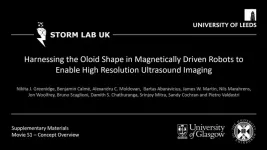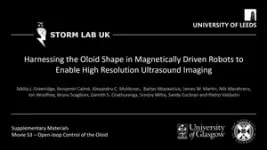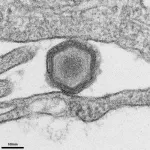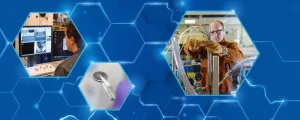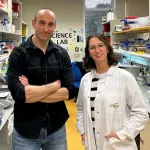(Press-News.org) Embargoed: Not for Release Until 2pm U.S. Eastern Time (6pm GMT) Wednesday, 26 March 2025
With images and videos
A tiny magnetic robot which can take 3D scans from deep within the body, that could revolutionise early cancer detection, has been developed by researchers.
The team, led by engineers from the University of Leeds, say this is the first time it has been possible to generate high-resolution three-dimensional ultrasound images taken from a probe deep inside the gastrointestinal tract, or gut.
It paves the way to a transformation of the diagnosis and treatment of several forms of cancer by enabling ‘virtual biopsies’ — non-invasive scans that provide immediate diagnostic data, allowing doctors to detect, stage, and potentially treat lesions in a single procedure: eliminating the need for physical biopsies.
The perhaps surprising key to the team’s success was the use of a little-known 3D shape, the oloid, which gave the magnetic medical robot a previously impossible range of motion – the roll – essential for precise navigation and imaging inside the body.
A paper, published today (March 26) in Science Robotics, explains how the team integrated the oloid shape, and its unique rolling motion, into a new magnetic flexible endoscope (MFE). They equipped it with a small, high-frequency imaging device to capture detailed 3D images of internal tissues.
This technology was developed through a collaboration between engineers, scientists, and clinicians from the University of Leeds, the University of Glasgow, and the University of Edinburgh. Leeds led the robotics development and integration of the probe, while Glasgow and Edinburgh provided the ultrasound probe and led the imaging component
Pietro Valdastri, Professor and Chair in Robotics and Autonomous Systems and Director of the STORM Lab, coordinated the research behind this paper. He said: “For the first time, this research enables us to reconstruct a 3D ultrasound image taken from a probe deep inside the gut - something that has never been done before.
“This approach enables in-situ tissue analysis and diagnosis of colorectal cancer, with immediate results. The process of diagnosing colorectal cancer currently requires a tissue sample to be removed, then sent to a lab, with results taking from one to three weeks.”
The imaging device – a 28 MHz micro-ultrasound array – creates a high-resolution, 3D reconstruction of the area it scans. From this virtual reconstruction, clinicians can make cross-sectional images that mimic those generated by a standard biopsy, in which a sample of tissue is sliced into thin layers and placed on a slide to be examined under a microscope.
High frequency, or high-resolution ultrasound, is different to the ultrasound most of us are familiar with, used to look at a foetus or internal organs. The high frequency/resolution ultrasound probe used in this study enables users to see features on a microscopic level, down to tissue layer level detail.
While 3D ultrasound can already be performed in blood vessels and in the rectum, this work opens the possibility for 3D scans to be performed deeper in the gastrointestinal tract.
Postgraduate researcher Nikita Greenidge, a member of Leeds’ STORM Lab, in the School of Electronic and Electrical Engineering, is lead author of the paper. She said: “By combining our advanced robotics with medical ultrasound imaging, we take this innovation one step ahead of traditional colonoscopy, allowing doctors to diagnose and treat in a single procedure — eliminating the wait between diagnosis and intervention. This not only makes the process more comfortable for patients but also reduces waiting times, minimises repeat procedures, and alleviates the anxiety of waiting for potential cancer results.”
She added: “Colorectal cancer is one of the leading causes of cancer-related deaths in the UK and globally, but if detected early it is highly treatable. This research presents a new approach that could significantly improve early diagnosis with a minimally invasive approach and could also, in future, facilitate targeted ultrasound-triggered drug delivery for more effective treatment.”
The research was funded by UKRI Engineering and Physical Sciences Research Council (EPSRC), the European Commission (EC), the European Research Council (ERC), and the NIHR Leeds Biomedical Research Centre. It found that using the oloid – a shape formed by two intersecting perpendicular circles – significantly enhanced the dexterity, diagnostic capabilities and autonomy of magnetic flexible endoscopes, and magnetic medical robots overall.
The oloid magnetic endoscope (OME) was 3D printed out of resin, measuring just 21 mm in diameter – around the size of a 1p coin - meaning the robot could still roll but was a practical size and design for clinical applications like colonoscopy. Its movement was tested on a range of surfaces simulating the structures of the colon, oesophagus and stomach.
To advance the technology toward human trials, the team first conducted tests in an artificial colon, followed by studies in pigs, a necessary step in meeting regulatory requirements for medical device approval. They used a robotically controlled external permanent magnet, a platform previously developed at Leeds which enables both joystick and autonomous control of the OME. Navigation was assisted by images from an embedded camera and a magnetic localisation system. The results demonstrated that the system could:
Successfully perform controlled rolling and sweeping motions inside the colon.
Generate high-resolution 3D ultrasound scans for accurate diagnosis.
Identify lesions in gastrointestinal tissue, showcasing its potential for advanced medical imaging and early disease detection.
Ms Greenidge said while this research had been conducted in the colon, the rolling properties of the oloid shape could be applied to a variety of magnetic medical robots, potentially expanding its applications to other areas of the body.
The team will now set about collecting all the data that will allow them to conduct human trials, which they hope could start in 2026, as the Leeds platform for robotic colonoscopy without ultrasound capabilities is already undergoing human trials and being commercialised by Atlas Endoscopy, a Leeds-based company formed out from the STORM Lab.
The science of magnetic robots
Magnetic fields are ideal for medical applications as they pass harmlessly through human tissue, enabling the remote manipulation of tiny surgical robots. Controlled rolling and sweeping motions are essential for precise navigation and imaging inside the body. However, it is impossible to make cylindrical robots roll, using an external magnetic field.
Cylindrical magnetic robots can only achieve five degrees of freedom – the ways an object can move. This was considered a limitation: 3D scans weren’t possible without the rolling motion. Although gravity would cause a cylinder or sphere to roll down a slope, it’s not possible to make them roll using external magnetic forces. Utilising the oloid has solved that problem as its unique geometry naturally facilitates a meandering rolling motion that couples the roll to the up-down and side-to-side rotations. Because the oloid does not have symmetry around a central axis, the external magnet can apply a torque – or twisting force – inside the body, in two directions, to bring about the rolling motion.
Ms Greenidge said: “Our findings suggest new possibilities for interdisciplinary approaches to medical robotics, showing how mathematical principles like simple geometry can solve real-world healthcare challenges.”
Professor Sandy Cochran, Centre for Medical and Industrial Ultrasonics at the University of Glasgow, who led the ultrasound component of the study, said: “Ultrasound imaging is safe, inexpensive and can be deployed exactly where it’s needed. Through this collaborative approach, linking medical ultrasound imaging and cutting-edge robotics, we hope to help bring about transformative changes in cancer diagnosis, treatment, and patient management.”
The team believe the advancements they have made could lead to a fundamental change in endoscopy, where endoscopists can focus on critical diagnostic and therapeutic decisions while autonomous systems handle routine navigation and tasks.
They also believe the OME’s enhanced dexterity and diagnostic capabilities could help address gender disparities in colonoscopies, as standard flexible endoscope procedures tend to be more challenging in women, leading to higher rates of incomplete procedures.
Jane Nicholson, Executive Director of Research at EPSRC, said: “Progress from cutting-edge technology developments is enabling the development of rapid, non-invasive solutions that have the potential to revolutionise cancer diagnosis and treatment.
“By improving the precision and control of procedures for high-incidence cancers such as colorectal cancer, the efforts of this interdisciplinary team could lead to significant advancements in cancer detection and treatment.”
Further Information
The paper ‘Harnessing the oloid shape in magnetically driven robots to enable high-resolution ultrasound imaging’ is published in Science Robotics March 26, 2025.
DOI: 10.1126/scirobotics.adq4198
Multimedia available via WeTransfer link https://we.tl/t-FpKw2i01ED
Please visit link above for additional video explainer not available on EurekAlert due to size of file. Caption: Video featuring Nikita Greenidge, postgraduate researcher at the University of Leeds and lead author of the paper, explaining how the team used the oloid shape to enable magnetic medical robots to roll, unlocking their potential to perform “virtual biopsies” that could detect and treat cancer in one procedure. Credit: STORM Lab, University of Leeds.
For more information, to arrange interviews, or to request a copy of the paper, email press officer Deb Newman via d.newman@leeds.ac.uk and pressoffice@leeds.ac.uk
Funding
This work was supported, in part, by the Engineering and Physical Sciences Research Council (EPSRC) under grants EP/Y037235/1 and EP/V047914/1, the European Research Council (ERC) through the European Union’s Horizon 2020 Research and Innovation Programme under grant 818045, the European Commission (EC) through the European Union’s Horizon 2020 Research and Innovation Programme under grant 952118, and the National Institute for Health and Care Research (NIHR) Leeds Biomedical Research Centre (BRC) (NIHR203331).
University of Leeds
The University of Leeds is one of the largest higher education institutions in the UK, with more than 40,000 students from about 140 different countries. We are renowned globally for the quality of our teaching and research.
We are a values-driven university, and we harness our expertise in research and education to help shape a better future for humanity, working through collaboration to tackle inequalities, achieve societal impact and drive change.
The University is a member of the Russell Group of research-intensive universities, and is a major partner in the Alan Turing, Rosalind Franklin and Royce Institutes www.leeds.ac.uk
Follow University of Leeds or tag us into coverage: Bluesky | Facebook | LinkedIn | Instagram
University of Glasgow
The University of Glasgow is a top world 100 University (THE, QS) and was the Times and Sunday Times Good University of the Year 2022.
The University is a member of the prestigious Russell Group of leading UK Universities and has annual research income of more than £180m.
As a world-leading, research-intensive University, the University of Glasgow is committed to contributing towards the UN’s 17 Sustainable Development Goals (SDGs) and has committed to carbon neutrality by 2030.
Glasgow was the first UK University to declare it would divest from fossil fuels within a decade and the first in Scotland to declare a Climate Emergency.
In 2021, the University of Glasgow received a Queen’s Anniversary Prize for its national service to the Covid-19 pandemic.
University of Edinburgh School of Engineering
Engineering has been taught at the University of Edinburgh since 1673 and today the School of Engineering is a thriving, international community of staff and students addressing the world’s critical challenges across all disciplines of engineering, from the nano to macro and global scales. A leading centre for engineering research and innovation, the School ranked first in Scotland and third in the UK for the quality and breadth of its combined engineering research with Heriot-Watt University, in the Research Excellence Framework 2021 (REF 2021), as published in Times Higher Education. The School is proud to have strong connections with industry, and research which translates into real-world impact.
National Institute for Health and Care Research (NIHR)
The mission of the National Institute for Health and Care Research (NIHR) is to improve the health and wealth of the nation through research. We do this by:
Funding high quality, timely research that benefits the NHS, public health and social care;
Investing in world-class expertise, facilities and a skilled delivery workforce to translate discoveries into improved treatments and services;
Partnering with patients, service users, carers and communities, improving the relevance, quality and impact of our research;
Attracting, training and supporting the best researchers to tackle complex health and social care challenges;
Collaborating with other public funders, charities and industry to help shape a cohesive and globally competitive research system;
Funding applied global health research and training to meet the needs of the poorest people in low and middle income countries.
NIHR is funded by the Department of Health and Social Care. Its work in low and middle income countries is principally funded through UK international development funding from the UK government.
END
Mini rolling robot takes virtual biopsies
2025-03-26
ELSE PRESS RELEASES FROM THIS DATE:
Researchers design tools to develop vaccines more efficiently for African swine fever virus (ASFV)
2025-03-26
Rockville, Maryland—March 26, 2024—Researchers from the J. Craig Venter Institute (JCVI), the Friedrich-Loeffler-Institut (FLI), and the International Livestock Research Institute (ILRI) have developed a reverse genetics system for African swine fever virus (ASFV). This new system will aid researchers in developing vaccines and in studying the pathogenesis and biology of ASFV, a highly contagious, deadly viral disease affecting domesticated and wild pigs, especially prevalent in Africa, Europe, Asia, and the Caribbean. A recent study estimates if ASFV reached the United States it could result ...
How survivors spanned the globe after Earth’s biggest mass extinction
2025-03-26
Scientists don’t call it the “Great Dying” for nothing. About 252 million years ago, upward of 80% of all marine species vanished during the end-Permian mass extinction – the most extreme event of its kind in Earth’s history.
What followed was a mysterious, multimillion-year span that could be called the “Great Dulling,” when marine animal communities looked remarkably alike all over the planet, from the equator to the poles. Researchers have long sought an explanation for this so-called taxonomic homogenization – a scene that played out after other mass extinctions over the past ...
Even in egalitarian Sweden, a "culture of silence" may prevent university staff and students from reporting sexual harassment
2025-03-26
Even in egalitarian Sweden, a "culture of silence" may prevent university staff and students from reporting sexual harassment, with just an 8.1% reporting rate for students who had experienced either rape or attempted rape.
####
Article URL: https://plos.io/4bW0elh
Article title: What determines the ‘culture of silence’? Disclosing and reporting sexual harassment among university employees and students at a large Swedish public university
Author countries: Sweden
Funding: This work was funded by the Swedish Research Council, ...
Data from the Healthy Minds Study of 140 college campuses in the US suggests that religiousness may be protective against symptoms of depression in students, although less so in sexual minorities
2025-03-26
Data from the Healthy Minds Study of 140 college campuses in the US suggests that religiousness may be protective against symptoms of depression in students, although less so in sexual minorities.
####
Article URL: https://plos.io/3XwiyM6
Article Title: Religiousness, sexual orientation, and depression among emerging adults in U.S. higher education: Findings from the Healthy Minds Study
Author Countries: Spain, United Kingdom, United States
Funding: The authors received no specific funding for this work. END ...
Idaho National Laboratory seeks sponsor for innovation incubator to support technology commercialization
2025-03-26
(IDAHO FALLS, Idaho) – The Idaho National Laboratory (INL) is seeking an industry sponsor to invest $5 million to $10 million in a privately funded innovation incubator. This program will combine the power of a national laboratory with private sector commercialization knowledge to unleash breakthrough innovations by finding and supporting promising startups in the areas of nuclear energy, integrated energy systems, cybersecurity and advanced materials.
The innovation incubator seeks to provide seed-stage startups aligned ...
Ochsner Health celebrates team members recognized as Louisiana State Nurses Association 40 Under 40 honorees
2025-03-26
NEW ORLEANS – Four outstanding Ochsner Health nurses have been named to the Louisiana State Nurses Association’s (LSNA) second annual 40 Under 40 list.
The LSNA 40 Under 40 list celebrates 40 future leaders of nursing in Louisiana who are 40 years of age and under, exemplify dedication to the nursing profession, and demonstrate exceptional leadership qualities.
“We are immensely proud of our Ochsner honorees. This recognition celebrates our nurses who fuel their purpose each day and use their voice to influence the growth of the nursing profession and how we deliver high-quality care to our patients and communities,” said Tiffany Murdock, senior ...
Study explores how time-restricted eating affects weight loss
2025-03-26
Time-restricted eating is the latest craze for people looking to lose weight, but whether it works is still the calorie-burning question.
A new study from the University of Mississippi shows that when healthy adults pair an eight-hour eating window with regular exercise, they lose more fat – without sacrificing lean muscle – compared to exercise alone, according to a study released in the International Journal of Obesity, which is published by the Nature Publishing Group.
“We saw that this did lead to more fat loss and reduced body fat percentage over time when healthy adults were following both exercise with time-restricting ...
Ochsner Health named 2025 Gallup Exceptional Workplace Award winner
2025-03-26
NEW ORLEANS – Ochsner Health, Louisiana’s largest non-profit, academic, multi-specialty, healthcare delivery system, has been awarded the 2025 Gallup Exceptional Workplace Award (GEWA) for employee engagement. This award recognizes the most engaged companies in the world and highlights Ochsner’s continued dedication to setting a standard of excellence in patient care and the workplace.
"Ochsner Health is honored to receive this recognition," said Pete November, chief executive officer, Ochsner Health. "Our commitment to fostering a supportive and dynamic workplace for our team members is directly ...
Researchers have discovered a new mechanism for rapid liver regeneration triggered by glutamate
2025-03-26
Research conducted by the National Cancer Research Centre (CNIO), published today in ‘Nature’, reveals a mechanism in mice that is triggered just minutes after acute liver damage occurs.
This finding opens up avenues for future treatments of serious liver damage to include a diet enriched with the amino acid glutamate.
Glutamate supplementation can promote liver regeneration and benefit patients in recovery following hepatectomy or awaiting a transplant, the authors write in ‘Nature’.
Activating liver regeneration is key to treating diseases that involve severe liver damage, which are becoming increasingly frequent and are associated ...
Scientists discover why obesity takes away the pleasure of eating
2025-03-26
The pleasure we get from eating junk food — the dopamine rush from crunching down on salty, greasy French fries and a luscious burger — is often blamed as the cause of overeating and rising obesity rates in our society.
But a new study by scientists at the University of California, Berkeley, suggests that pleasure in eating, even eating junk food, is key for maintaining a healthy weight in a society that abounds with cheap, high-fat food.
Paradoxically, anecdotal evidence suggests that people with obesity may take less pleasure in eating than those of normal weight. Brain scans of obese individuals ...
